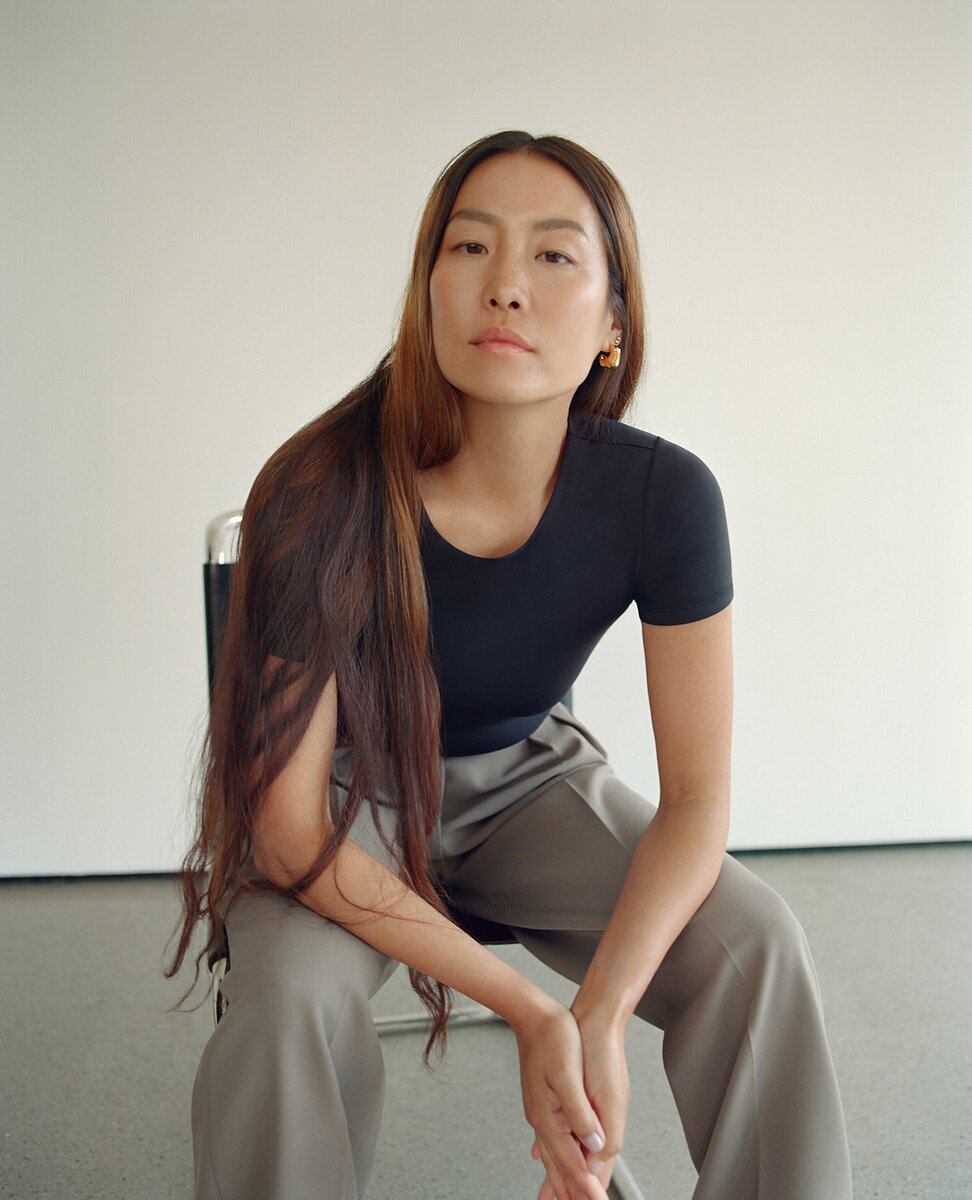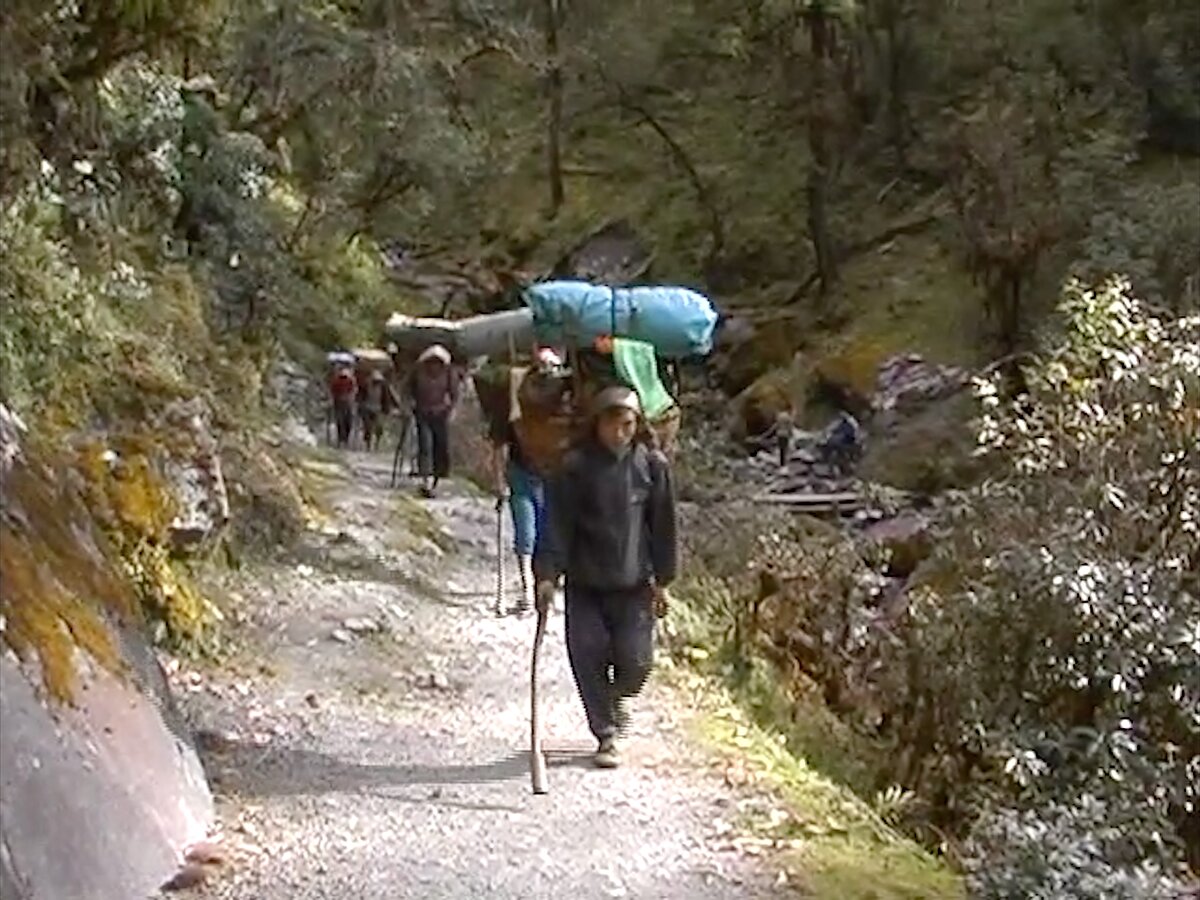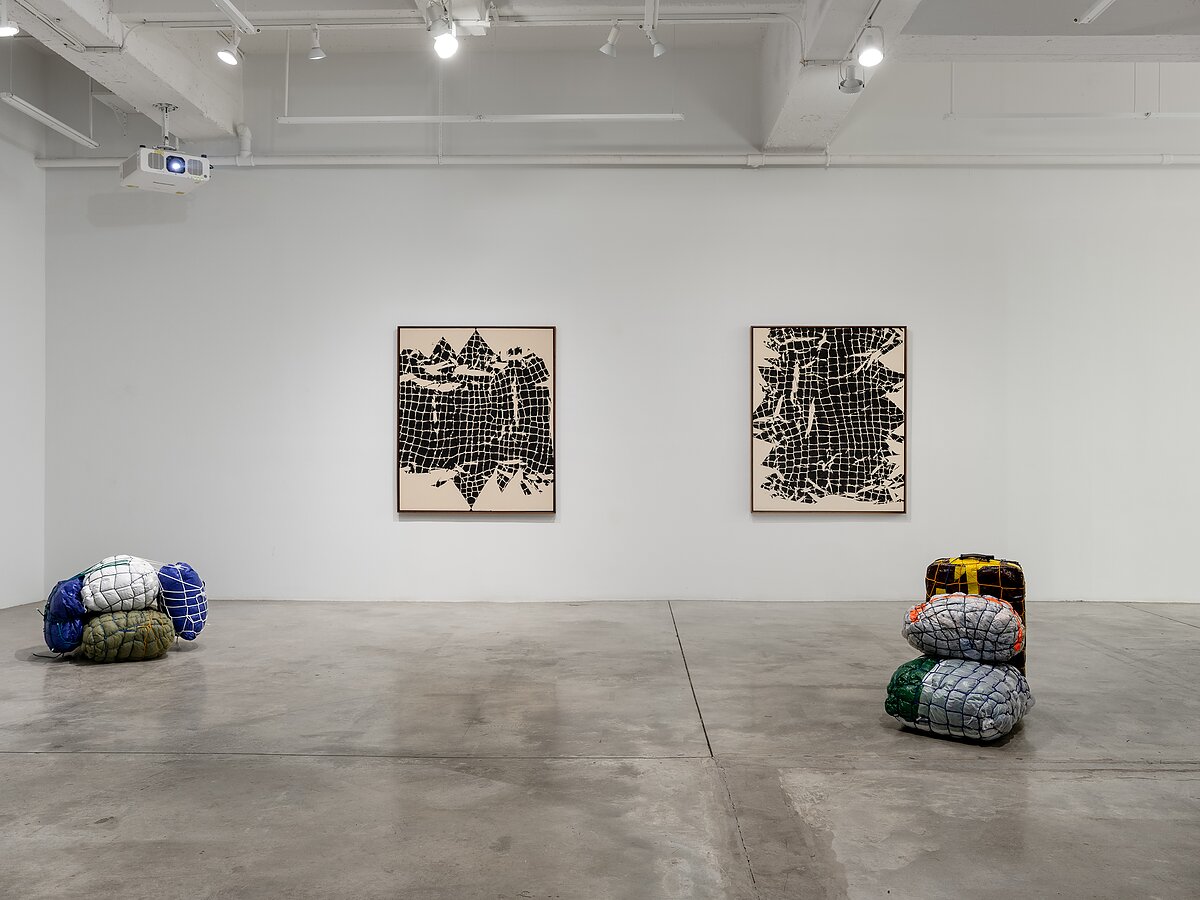Artist Maia Ruth Lee on Finding Meaning in Rootlessness
For artist Maia Ruth Lee, migration has been a constant since childhood. Born in Busan, South Korea, Lee’s first experience being uprooted happened when her parents moved the family to Nepal in the ‘80s to work as Bible translators. While the multidisciplinary artist has since relocated to Seoul and New York, it was largely her time in Nepal that has informed the core of her artistic practice which spans sculpture, painting, photography, and video. Lee’s recent exhibition at Tina Kim Gallery, “The skin of the earth is seamless,” as well as her video work The Stranger (2018)—currently on view at “Listen Until You Hear,” a joint presentation by Fotografiska and For Freedoms—offer intimate explorations of what it means to call a new place home.
The root of this exploration is Lee’s sculpture series, “Bondage Baggage.” Inspired directly by the distinctive Nepalese method of packing luggage with a netlike weave of found fabric and rope, the objects in this series appear as if they might burst if not for their bonds. This tension speaks to the tenuousness of migration and the push-and-pull of identity—what are the forces that define who a person is?
These days, Lee lives in Colorado—she and her family moved there unexpectedly in 2020 when COVID made it impossible for them to return to New York from Los Angeles—which has allowed her to quite literally unpack her “Bondage Baggage” sculptures, allowing them to spill forth and expand. Over a Zoom interview from Busan, South Korea where Lee was visiting her parents, the artist discussed the intimacy of these new works, the strangeness of parenthood, and her reflections on uprootedness with The Amp’s Shannon Lee.
MRL: It’s kind of just a feeling. I think COVID-19 reset Korea in an odd way. The last time I was here, there was such an overwhelming amount of visible capitalism. There still is but it seems like it’s leveled out a bit. People seem a little more low-key or something. The last time I was here, it felt like everyone had cosmetic surgery and was wearing designer handbags. It was overwhelming. It doesn’t seem as flashy as it did four years ago. But maybe that’s just my perception and indicative of where I’ve been going. I had lived in Korea for 10 years growing up so I’d seen its progression in the early 2000s. I just remember feeling very suffocated towards the end of my time there. I have a lot of love and hate for this place.
It’s been so interesting coming back with the context of being represented by a Korean American gallery. I never thought that was important to me but it makes sense; this is where my journey in art began. Growing up and visiting these institutions, I never would have thought I’d be back and having specific meetings about my work. It’s way more meaningful than having something in Europe, for example. I’m enjoying this homecoming feeling.
MRL: It’s his second time but he doesn’t remember his first time because he was one. He’s five now and seems to really like it. It’s been interesting to watch him experience Korea. He’s perceiving it from the snacks and the grandparent’s love and all the fun stuff that I’m showing him but it’s really awesome to watch him learn Korean. It’s something that I hadn’t been great at doing on my own.
Language is funny; without context, it doesn’t make much sense. If I’m teaching Nima Korean by myself in my town where there are only five or six other Asians, Korean just becomes this secret language with mom. Whereas here, he understands it’s a whole language and culture. It’s an entire universe.
I love that he’s learning Korean in this context for the first time. Now when we take it back to Colorado and I’m speaking with him and adding on new vocabulary, he understands where it’s coming from. I’m excited about that.
MRL: The Letter is actually the second iteration of a three-part video series. The first one is called The Stranger (2018), which is currently part of a group show at Fotografiska organized with For Freedoms titled “Listen Until You Hear.” That video debuted in 2018 and was the first time I’d used family footage to recreate narratives. The Letter is slightly different. It’s still a dialogue between my father and I but while the first one has my father’s voiceover as part of the video as he’s shooting the footage, this most recent video doesn’t.
In the first video, I synced my own text to loosely translate what my father is saying but there are moments that don’t quite align. As a viewer, if you don’t speak or understand Korean, you wouldn’t be able to really know that was happening until around midway through the video when I’m talking about something that’s clearly not from a male’s perspective; I speak about pregnancy and postpartum. Around midway through the video, you see these two voices splitting off each other. In the second video, I took out all the audio and just left the ambient background noise because I wanted the letters to drive how the viewer was let into the video.
I have no idea what the third video is going to be. But I do have hours and hours of footage. I’m so glad that my father had the foresight to document our time in Nepal. I wasn’t actually going to include The Letter in the exhibition but Junni Chen, a director at Tina Kim Gallery, suggested it would be a good way to introduce the works because it comes from such a personal place and would add so much context.
MRL: It really is magical! All of a sudden, you’re there again. It’s not just this thing in the back of your mind; you can see all the colors and textures and feel the air and hear the voices. I was really excited. At first, I thought there’d only be a few tapes for me to look at. I saved a lot of the more intense footage for the last video. My dad shot so much stuff—different rituals, sacrifices. There’s a lot that captures what it’s like to grow up in Nepal. There are a lot of intense memories.
We don’t have this on film but I remember our landlord lived downstairs from us. They were a Hindu family and they had a tradition where whenever they bought a new vehicle, like a motorcycle or something, they would go through a whole ceremony where they would bless the vehicle, pray to the gods for no accidents, etc. They had brought in a goat and I had gone upstairs. When I came back down, the goat was still there but without a head and it was jumping all over the grass. I remember that being a core memory for me.
But childhood is funny because looking back, I’m like, “was that real?” It’s nice when you can confirm that some of these things were true.
MRL: Moving to Colorado was kind of an accident. It wasn’t part of our plan. We were visiting Los Angeles when COVID-19 hit New York. It was mere timing that brought us to Colorado. We couldn’t fly back during that time so we had to make the difficult decision to shut down our operation in New York because we couldn’t afford to keep it running. We hired movers and they packed everything in our studios and apartments over FaceTime. It was this sudden move that we had to partake in.
The most logical thing was for us to go to Colorado. My husband Peter’s mother was also stuck in Florida at the time and her house in Colorado was empty. We decided to take advantage of that. We went there for a few months and then decided to explore the area. We decided on a small town called Salida. We went there mostly to be in nature. It has access to rivers and mountains and hills. Through that time, it was still very strict and people were still very quarantined. We ended up really liking it a lot. We were only supposed to be there for two months and now we’ve been there for over three years.
There was a lot of questioning and trying to figure out if we were making the right decision, not just for ourselves but also for our child. I was thinking about my parents a lot. My parents left Korea for the very first time when they were in their early 30s—we left in 1986 when Korea was just starting to open up. They didn’t speak any English so they had to learn Nepali, English, and Sherpa. For them to leave their families and friends as linguists and Bible translators for this unknown territory with kids is terrifying. I never really thought about that before. For us, the reason why we stuck to our guns was to prioritize our son’s health and safety and happiness and growth.
The time that my dad shot a lot of this footage was the same age I was when I had been writing these letters to my friends between 2020 and 2022. I imagined that a lot of the questions and concerns that I had written in these letters were also held by my parents. Maybe they were writing similar letters to their friends and family back in Korea.
I haven’t shown this video to my parents yet; I feel almost shy to. They know that my father’s footage is in it and he jokes about he’s an artist now too. And he is! But someday I’ll be able to share the video with them.
MRL: That series kicked off around 2010. I returned to Nepal for the first time as an adult after a really long time away. One of the first things I saw was the luggage coming down the conveyor belt at the Kathmandu airport. I had seen these objects the entire time I was growing up but I never really noticed them. They drew me in at first aesthetically; if you walk into the Kathmandu airport right now, half of the luggage is packed that way. Each one of them uses different materials—bed sheets, boxes, tape. Every one of them is an art form.
For about five years, I was taking photos of them, collecting these images but not really knowing what to do with them. I knew there was something to them and I thought they were so interesting but I didn’t quite know what they meant. I sat on them for a while; in that time, I’d arrived in New York. While I was there, I started thinking about migration and diasporic life for the first time in earnest. It was the most different life I’d lived up until then, having only lived in East and South East Asia.
I was really connecting with the concept of otherness and I kept going back to these photographs. I had made a zine, made collages, painted, and drew them but I knew I still hadn’t gotten it yet. I really wanted to bring out the materiality of these objects. When I visited Nepal, I bought a bunch of materials from the hardware store—tarp, tape, rope—and tried to closely imitate them. After I made a few prototypes, I felt like I had landed on something. It was a really long time coming.
I showed a version of them at the Whitney Biennial and then kind of left them for a while again. Upon moving to Colorado in 2020, the sculpture began making more sense to me. I was so sick of lugging things around and was thinking a lot about what baggage meant. What are the objects you choose to carry with you? What does that mean?
I had a desperate need to translate the sculptures into something beyond the object. I wanted them to lose their content but still have the markings and memory of the shape and form. I replaced the tarp with canvas and started painting the entire sculpture with ink and when I unbound it, I was so thrilled when it worked! There were so many layers to it and it made me so excited about what I was doing. That can be such a rare feeling; knowing that you can continue to investigate something further and further.
I don’t think I would’ve been able to make these paintings if I was still in New York. Colorado gave me the space and opportunity to explore.












